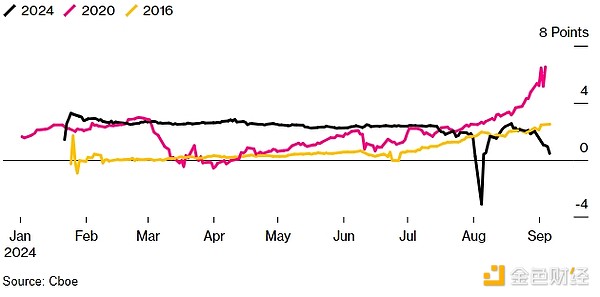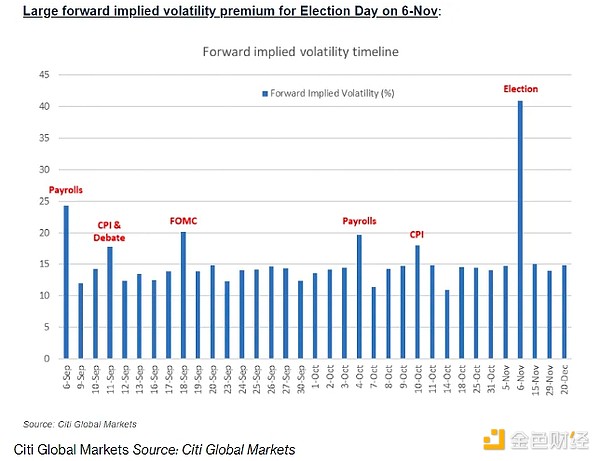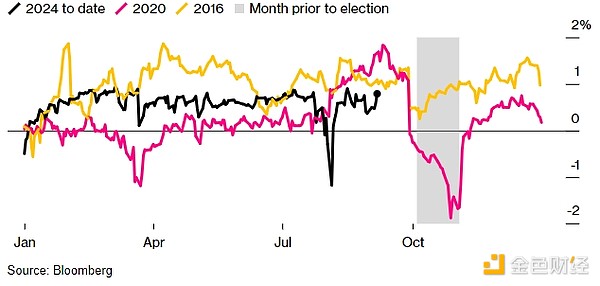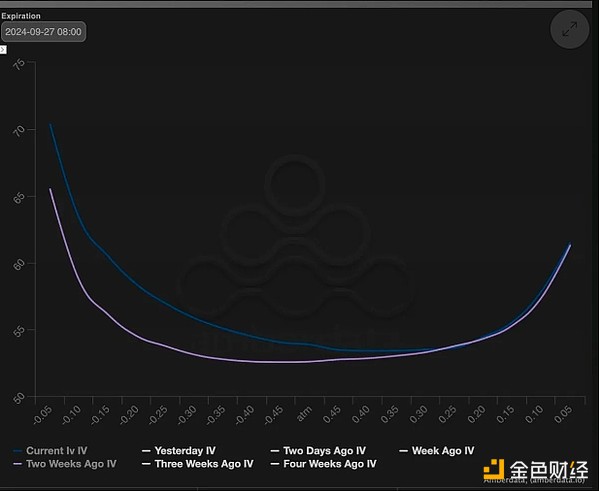Source: Bloomberg; Compiled by: Deng Tong, Golden Finance
In global financial markets, options traders are preparing to make a wave of bets related to the US election as soon as the Federal Reserve's policy statement ends.
The fiercely competitive presidential election has gradually faded from people's sight, and investors are focusing on the Federal Reserve's meeting on September 18.Any policy mistakes could disrupt markets that are already nervous about signs of slowing economic growth.
“The main near-term focus of the market is likely to be the Federal Reserve and the start of a rate-cutting cycle,” said Rocky Fishman, founder of derivatives analytics firm Asym 500. While equity options are pricing in higher risk around Election Day, actual trading volume around election-related expiration dates has been limited.”
Traders are also awaiting Tuesday’s debate between Kamala Harris and Donald Trump before determining who will win the race. Investors will analyze the candidates’ positions on issues including tariffs, immigration policy and corporate taxes.
Higher tariffs and tighter trade restrictions could push up inflation at a time when the Fed has just begun to signal a willingness to cut rates. Meanwhile, Goldman Sachs Group Inc. strategists said Harris’ proposal to raise the corporate tax rate to 28% from 21% could reduce earnings for S&P 500 companies by about 5%.
Here’s where the options market is positioned for stocks, currencies and other markets:
Stocks
Contracts for the Cboe Volatility Index (VIX), Wall Street’s closely watched fear gauge, look more benign than they did four years ago. The VIX forward curve shows less of a “distortion,” with October futures (a measure of volatility for November S&P 500 options) trading at a much lower premium to September and November contracts than in 2020 or 2016.
VIX election premium is small: October’s premium is down from September and lower than the past two election seasons

“Aside from continued buying in October VIX futures, we haven’t seen a lot of specific positioning ahead of the election,” said Steve Sosnick, chief strategist at Interactive Brokers. “Open interest is not particularly large, which means that most of the price increase has been defensive rather than the result of huge demand for protection.”
However, election-implied volatility in the S&P 500 has been increasing, especially since August, according to Garrett DeSimone, head of quantitative research at OptionMetrics. Since the beginning of the month, it has reached more than 1.5% last week.

“The election outcome is likely to be a 50/50 win or lose, so we will focus on holding volatility rather than a directional view,” Stuart Kaiser, head of U.S. equity trading strategy at Citi Global Markets, wrote in a report. “Implied volatility tends to rise closer to election day, and if volatility eases over the next month, we will take the opportunity to buy options or trade calendar spreads to reduce costs.” 16px;">
Currencies
Foreign exchange options traders also appear optimistic - they are preparing for a close election while suggesting that the risk of a trade shock will decrease if Trump is re-elected.
To measure the election risk premium priced in by currency markets, traders can now look at the difference between three-month implied volatility for a given exchange rate (which captures voting day on November 5) and the one-month period (which does not yet capture it).
The euro and the yuan are two of the currencies most vulnerable to higher tariffs in the Trump 2.0 era. However, the gap between three-month and one-month volatility in the common currency and the offshore yuan remains within normal ranges.
RMB volatility not yet reflecting election anxiety: spread between 3-month and 1-month USD/CNH implied volatility

For the RMB, the spread is currently around 80 basis points, below its level in July. For the euro, the spread is currently around 45 basis points, also well below its range since mid-2023. In the case of the RMB, its reading lags behind similar readings in the 2020 and 2016 election cycles.
This may change as the election date approaches and more campaign events, interviews, and presidential debates force each candidate’s views into the open. One-month implied volatility measures naturally see a sharp rise in early October, just as they did in 2016 and 2020.
Crypto
John Divine, head of over-the-counter trading at BlockFills, a trading and technology firm in the digital asset space, said that Bitcoin's positioning is unusually bleak in the short term.
"The bet right now is bearish until October 25 and slightly bullish before the election,"he said. "When we look at November, we start to see calls being bid higher than puts, but that's not the case, which is pretty shocking to me. It shows that there's a lot of fear in the market right now."

Bitcoin's recent trend is bearish Source: Amberdata
Devine said that while Trump is more favored by the cryptocurrency market overall, the lines are becoming increasingly blurred as to who is more supportive of cryptocurrency.
“I think right now the market is not entirely focused on who is going to win in November,” he said. “It’s more that they are using this story to push a narrative that fits their current stance, which is bearish.”
 JinseFinance
JinseFinance










